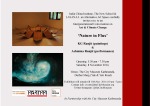
Roundtable with Nepali artists in Kathmandu.
Climate change is the defining issue of our times. While the impacts of climate change are unevenly experienced around the world, communities in the Himalaya are some of the most vulnerable to change. Understanding and communicating these emerging changes is an increasingly important task for public engagement and education.
There is no question that addressing climate change requires the best available science, but as we have learned, science alone is not enough to create action on climate change. To change people’s hearts and minds, and advance innovative and adaptive solutions to our current climate crisis, appeals to people’s deeply held values, ethics and spiritual beliefs are necessary—and it is here that creative thinkers (e.g. artists, writers, poets) have historically played a critical role in social change by making space for a diversity of voices and views.

Artists meeting on climate change in India.
Synergies between the arts and sciences, politics and the humanities, are strengthening movements calling for new ways of relating to people and the planet. This includes highlighting our ability to propose alternative practices, raise public awareness, and take political action in these times of crisis despite widespread apathy and political inaction. These emerging global movements of diverse peoples have taken the lead on climate change action and remind us that all life on the planet is interconnected, and that our actions, or inactions, impact everyone.
Responding to these needs, artists, poets, writers, photographers and filmmakers who live and work in the Himalaya are taking a more active role in documenting and presenting these changing climate landscapes to the public. To support these efforts, the India China Institute at The New School in New York and LASANAA, an alternative art space in Nepal, are working to develop a new collaboration focused on engaging the arts and humanities around climate change and the Himalaya.

Nepali performance artist Ashmina Ranjit.
The first collaborative event included a discussion on November 8 with over two dozen Nepali artists and intellectuals (photo above), and was followed by a week-long inaugural exhibition featuring the works of esteemed Nepali artists KG Ranjit and Ashmina Ranjit. This combined exhibition, which ended on November 15, presented an inter-generational interpretation of the climate change crisis through paintings and performance art. The event was designed to foster further dialogue between the arts and humanities and social sciences, and is part of a broader effort by the India China Institute to broaden debates on climate change in the Himalaya.
These initial events will be followed by a series of ongoing conversations with artists and humanities scholars and intellectuals focused on the role of the arts and humanities in addressing climate change and other pressing social issues in the Himalaya. A copy of the postcard advertising the joint “Nature in Flux” event at the City Museum with ICI and LASANAA can be seen here.
Climate Change Himalaya – Artists On Climate Change

ICI Senior Director Ashok Gurung greets attendees.
The event at the City Museum with Ashmina Ranjit and KG Ranjit was a great success. Not only was there a significant turnout at the opening performance, but also excellent media coverage in Kathmandu of the performance and event. Here’s an excerpt of the coverage from the Kathmandu Post on Nov 14th. You can read all the compiled media coverage here (pdf).
Seated on a chair, Ashmina Ranjit wore a white gown and a cream-coloured sleeveless coat made out of lokta. There were two tables placed before and beside her. One with a computer with a count-down timer on its display and another that had a bowl filled with stainless-steel pins. Pins were scattered on the floor, and were pinned to her silk dress and her coat. Ranjit, all the while, took pins from the table and one by one pierced them through her coat and gown. When I reached the City Museum gallery, Durbar Marg, on November 9, afternoon, the timer on the computer had four hours on it still. Ranjit had been working on her ‘dress of pins’ for 20 hours already.
This was an exciting opportunity for both the India China Institute and some of our network of artists to begin thinking about how climate change and the arts intersect in a critical area like the Himalaya. ICI is looking forward to many productive conversations, both with New School faculty and students, as well as our international partners, on this topic in the future.
You can see a short video clip from her performance below.
This initial meeting and events in Nepal in 2014 was followed up in 2015 with a week-long workshop and series of meetings in Shimla, India, where a group of 15 artists from India, China, Nepal and the US came together to continue these discussions about climate change and the arts. This meeting was also a good success, with many productive ideas and important connections made between artists in the Himalayas, as well as between New York arts educators and practicioners all interested in climate change issues.
You can read more about the 2015 meeting here. As this project continue to evolve into a larger initiative, we will post new updates here.


